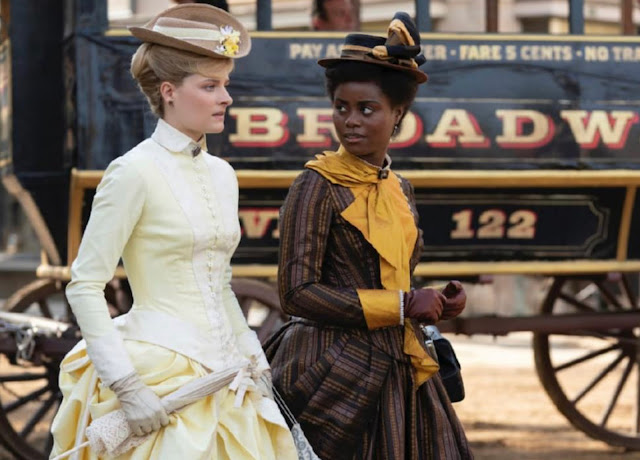 |
| Unusual parties of all sorts were commonplace in the Gilded Age. Hostesses were always making attempts to outdo one another in creativity and novelty. The guests at this event wore dominoes? Where? In their hair? The report tells us that the ladies were “elegantly costumed” but fails to mention how they wore the dominoes and why they wore dominoes. But the domino party is certainly not nearly as creative or novel as the “Doll Tea Party” with young adults mainly in attendance during an episode of Julian Fellowes’ and HBO’s “The Gilded Age.” – “Whether their fortunes were old or new, members of Gilded Age society reveled in hosting and attending teas, cotillions, lawn parties, luncheons, and formal dinners—all of which had their own codes of dress and manners. Even picnics were served on fine china.” – SmithsonianAssociates.org |
A Brilliant Domino Party
A brilliant levee was held last evening at the residence of Mrs. Thomas Hildreth, corner of Seventh and Reed streets. The guests wore dominoes, and the ladies were elegantly costumed. The reception was given by Miss Diana Murphy, assisted by Miss Virgie Murphy. Mrs. Dan Murphy and Miss Diana received the guests. The elegant mansion was a blaze of light from top to bottom. The dancing floor was covered with canvass, and at 9:30 dancing commenced. Parkman's band supplied the music.
The company represented the creme de la creme of San Jose society. At 11:30 the dominoes were removed, and at 12 o'clock supper was announced. This important adjunct of the event was conspicuous for its bounty and luxurious provision. It was a royal banquet. Everything passed off in the happiest manner. Miss Diana Murphy is a charming young lady, and her management of this congress of beauty and fashion was a triumph of generalship. Many of the dominoes were quite novel in pattern and color, and the whole affair was characterized by elegance and strict etiquette.
Following is a list of the guests: Miss Annie Colambet, Miss Lois Singletary, Miss Effie Smith, Miss Marcella Spring, Miss D. Sinnott, Miss Ada Ryland, Miss Ryland, Miss Mamie Cory, Miss Carrie Campbell, Miss Gertrude Moore, Miss Amelia Fisher, Miss Virgie Murphy, Miss Viola Lawrey, Miss May Bethell, Miss Lou Bethell, Miss Florence Younger, Miss Gussie Younger, Miss Alice Younger, Miss Fannie Enright, Miss Mary A. Enright, Miss Emma Hildreth, Miss Laura Hildreth, Miss Linda Hildreth, Miss Polhemus, Miss Ida George, Miss Mattie George, Miss Mamie Wilson, Miss Jennie Wilson, Miss Fannie Montgomery, Miss Belle Montgomery, Miss Sallie Trimble, Miss Maggie Trimble, Miss Susie Stone, Miss Ida Davis, Miss Leonia Gambert, Miss Kate Lewis, Miss May Lewis, Miss Lucie Houghton; Mr. and Mrs. Frank Staples, Mr. and Mrs. Dr. Caldwell, Mr. and Mrs. Dr. Thorne, Mr. and Mrs. Charles Hensley, Mr. and Mrs. Capt. Maddox, Mr. and Mrs. Col. Younger, Mr. and Mrs. Joseph Enright, Mr. and Mrs. J. M. Murphy, Mr. and Mrs. Dr. Ben Cory, Mr. and Mrs. Dan Murphy, Mr. and Mrs. J. T. Murphy, Mr. and Mrs. T. W. Spring, Mr. and Mrs. P. McArdle, Mr. and Mrs. Dr. Finigan; Mrs. T. H. Burke; Messrs. Joc Ellis, Chas. B. Hensley, Wm. George, Fred. Saxe, Nich. Bowden, Col. Younger, Mr. Schrieve, Horace H. Stevenson, Ed. Rhodes, Chas. Williams, Ned Younger, Shelby Stone, J. B. Clark, A.W. Inglesby, Frank Metcalf, Frank Lewis, O. N. Kent, D. W. Wallis, C. M. Shortridge, Chas. White, Geo. Polhemus, Clemi Columbet, Chas, Chapman, Dan Murphy Jr., Peter Columbet, J Columbet, Willie Beans, Robt. Brennam, J. R. Loeb, W.L. Gill, John Ryland, Jos. Barry, Joe Maddox, Harry Pierce, John Cory, Howell Moore, T. W. Hobson. – San Jose Mercury, 1881
🍽Etiquette Enthusiast, Maura J. Graber, is the Site Editor for the Etiquipedia© Etiquette Encyclopedia









 Numerous corn forks, corn holders, corn “strippers” (also marketed as corn “scrapers” and corn “slitters”) were patented from the Gilded Age well into the mid-20th century.
Numerous corn forks, corn holders, corn “strippers” (also marketed as corn “scrapers” and corn “slitters”) were patented from the Gilded Age well into the mid-20th century. 













